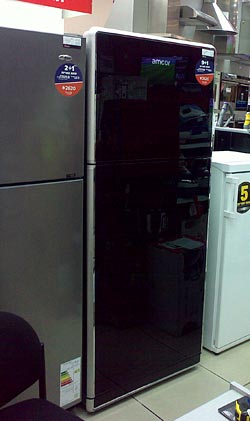The idea of a time traveler messing up the present by changing the past is a Sci-Fi staple, and is used to good advantage in Ray Bradbury’s 1952 short story, “A sound of thunder”. Bradbury’s subtlety is sadly lost in the 2005 movie of the same name; here, silly looking monsters run amok in the perturbed present of the movie. If you haven’t watched it, you may wish to save your time for something better.
However, there is one monster that caught my attention. This is a 50-foot eel-like monster that happily chases the humans in the flooded subway tunnels. here are two shots of its head:

These photos don’t do the eel justice -this is one creature you don’t want to be close to – but what struck my associative imagination at once was the certainty that I’ve seen this face before!
 You can see where I’d met it in the image at right. This is a detail from John Tenniel’s illustration of the Jabberwock, the monster in Lewis Carroll’s immortal nonsense poem from the second Alice book, “Through the looking glass”. Here is the very same bulbous head on a long neck, with the four tentacles and the bulging eyes. Only the dentition is different.
You can see where I’d met it in the image at right. This is a detail from John Tenniel’s illustration of the Jabberwock, the monster in Lewis Carroll’s immortal nonsense poem from the second Alice book, “Through the looking glass”. Here is the very same bulbous head on a long neck, with the four tentacles and the bulging eyes. Only the dentition is different.
So how did the Jabberwock and the Eel come to be so similar? I see two possibilities. Perhaps the movie’s effects people had seen the Tenniel classic and copied it, consciously or otherwise. But if they haven’t, we may have here a strange case of convergent evolution, where two unrelated creatures evolve in parallel under similar constraints and attain the same outcome. What parallel constraints, you ask? Well, in both cases the artists were striving to objectify nonsense. Carroll’s Jabberwock is part of a wonderful nonsense poem; whereas the movie, though far from wonderful, is itself a sorry piece of cinematic nonsense!



 Apple Computer’s incredibly talented design team has had a major influence on the design of contemporary mobile electronics: just visit a cellular phone store and you’ll see how all the companies are scrambling to copy the iPhone’s sleek look and feel, both the hardware and the software.
Apple Computer’s incredibly talented design team has had a major influence on the design of contemporary mobile electronics: just visit a cellular phone store and you’ll see how all the companies are scrambling to copy the iPhone’s sleek look and feel, both the hardware and the software. Here is a screenshot from the form you fill to join the El Al Frequent Flier club. The form has the usual fields (take my word for it, you to whom Hebrew is Greek), but the one that drew my attention is the Title field preceding the first name. This uses a drop-down box, which presents a very comprehensive set of options: there’s Mr and Mrs, There’s Dr, there’s Prof and Rabbi (hey, this is El Al), and there’s even Adv and Judge. But the one highlighted in the screenshot is – get this – Lord.
Here is a screenshot from the form you fill to join the El Al Frequent Flier club. The form has the usual fields (take my word for it, you to whom Hebrew is Greek), but the one that drew my attention is the Title field preceding the first name. This uses a drop-down box, which presents a very comprehensive set of options: there’s Mr and Mrs, There’s Dr, there’s Prof and Rabbi (hey, this is El Al), and there’s even Adv and Judge. But the one highlighted in the screenshot is – get this – Lord.


 I was in a building where someone decided to give the signage a modern look, and I saw this sign outside a restroom. The people have this angular look, with slanted heads – why not? Anything for effect…
I was in a building where someone decided to give the signage a modern look, and I saw this sign outside a restroom. The people have this angular look, with slanted heads – why not? Anything for effect… Check the
Check the 

 “He carefully cleaned out his active volcanoes. He possessed two active volcanoes; and they were very convenient for heating his breakfast in the morning. He also had one volcano that was extinct. But, as he said, “One never knows!” So he cleaned out the extinct volcano, too. If they are well cleaned out, volcanoes burn slowly and steadily, without any eruptions. Volcanic eruptions are like fires in a chimney.”
“He carefully cleaned out his active volcanoes. He possessed two active volcanoes; and they were very convenient for heating his breakfast in the morning. He also had one volcano that was extinct. But, as he said, “One never knows!” So he cleaned out the extinct volcano, too. If they are well cleaned out, volcanoes burn slowly and steadily, without any eruptions. Volcanic eruptions are like fires in a chimney.”